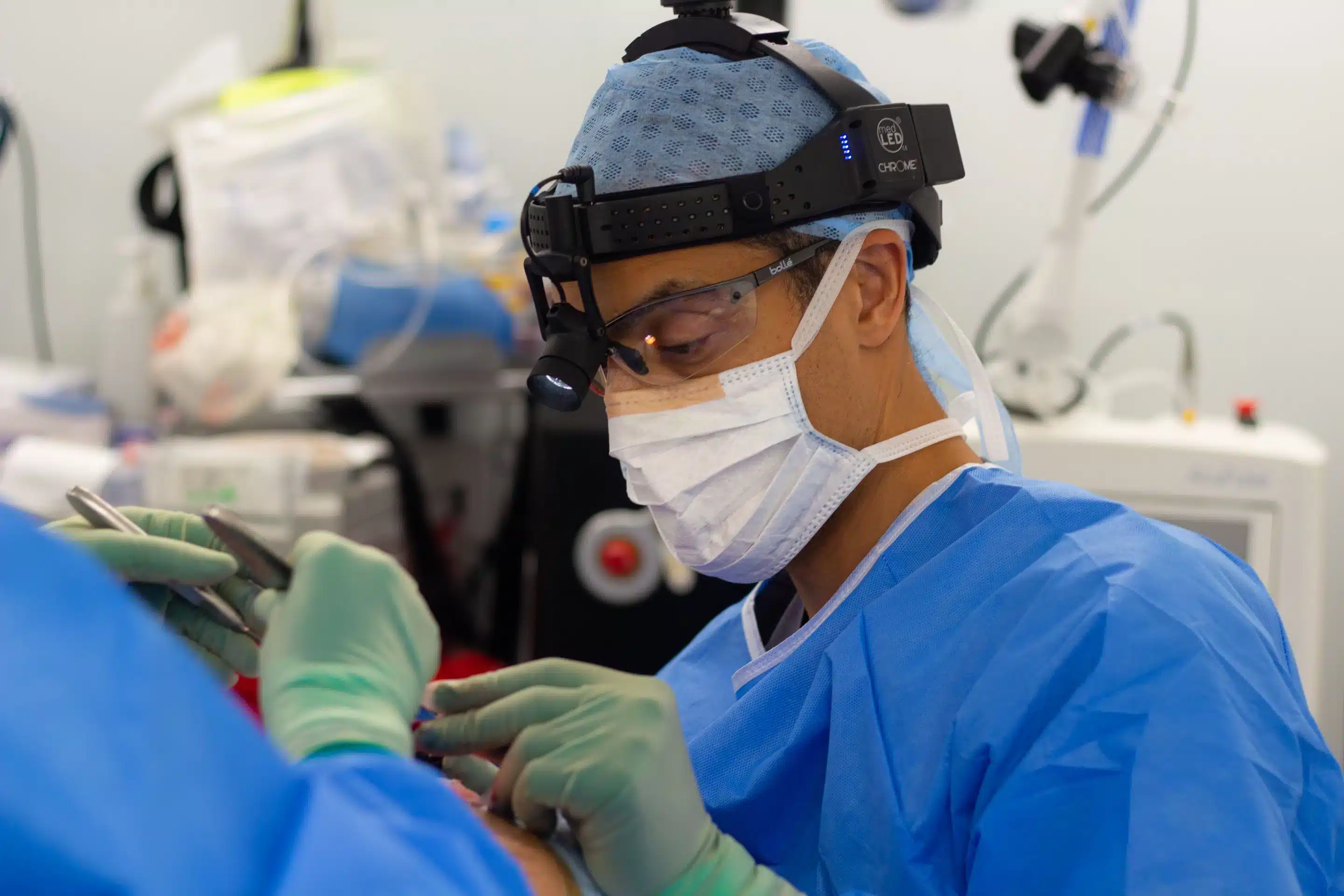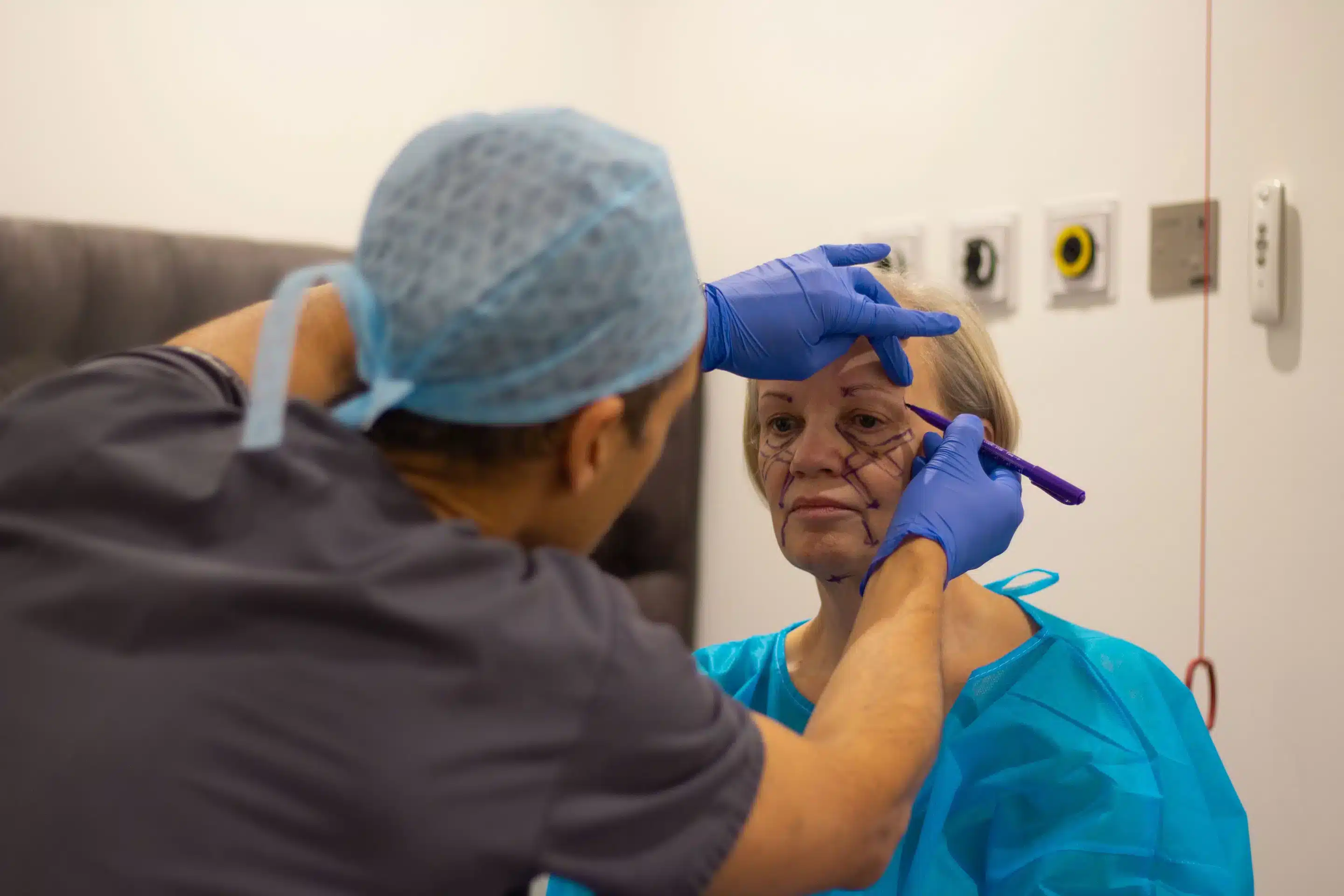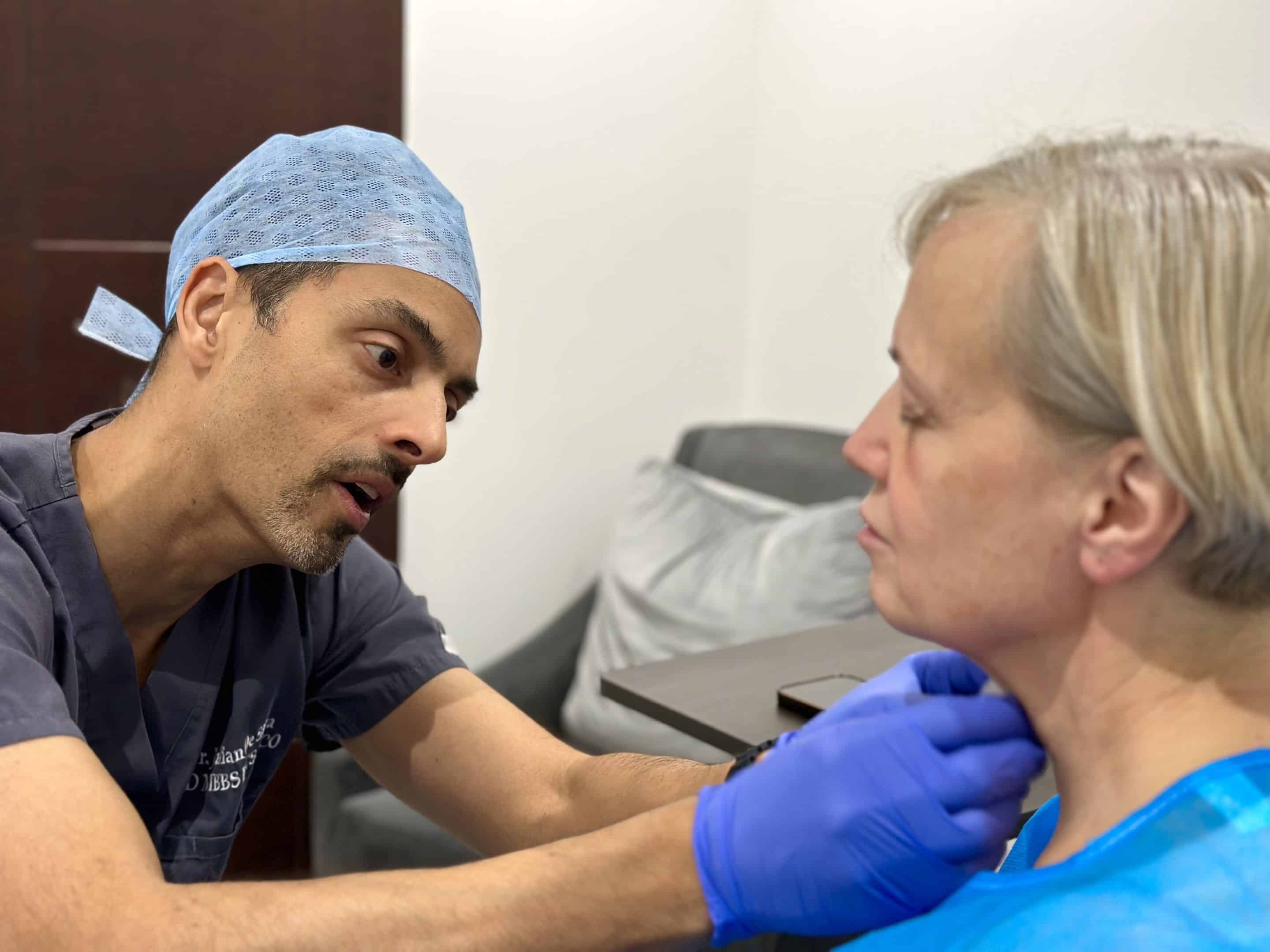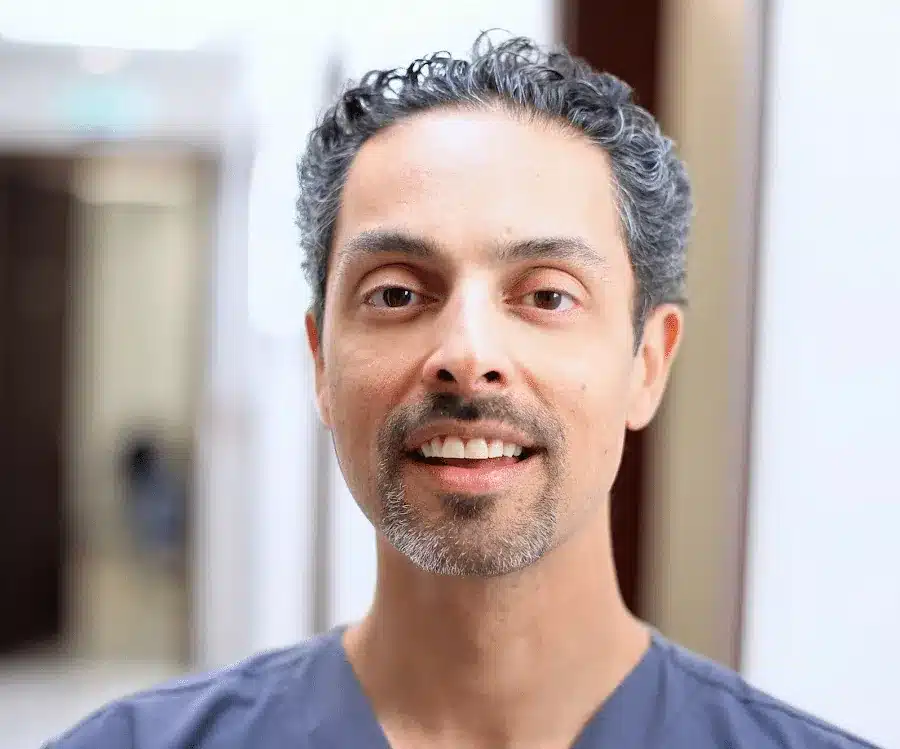
Find out everything you need to know before considering a facelift.
Welcome to our ultimate guide to facelifts. I’m here to help you understand everything there is to know about this process, from costs to care after the procedure.
Want to know what care you need after a facelift London? I’ll talk about that. Worried about costs? I’ll break it down for you. Heard about the trendy ponytail facelift and want to know more? I’ve got a whole section on it.
If you’re wondering how to choose the best surgeon for your facelift, I have tips. I’ll also discuss tanning after surgery and the different types of facelifts, including lower facelifts.
And if you’re not sure which facelift is right for you, I have advice for that, too. So dive in, and enjoy exploring all things facelifts with me.
Surgical Vs. Non-Surgical Facelift London | Harley Street
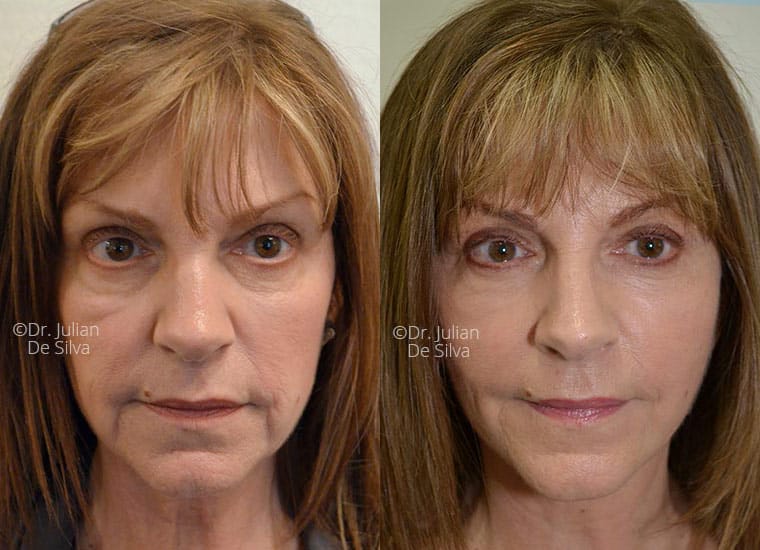
Find the differences between a surgical and non surgical face lift London.
We consult with many individuals who are interested in correcting signs of ageing on their faces. When it comes to overall facial rejuvenation, a facelift has long been the gold standard among cosmetic plastic surgeons. Facelifts are able to correct nearly all of the signs of ageing on a face and “turn back the hands of time.”
Facelifts, however, are invasive surgical procedures that are costly, require a somewhat lengthy recovery period, and carry with them a certain amount of risk. For these reasons, many people are unable to unwilling to undergo a facelift. For those wishing to correct signs of ageing on the face without surgery, a nonsurgical facelift may be a good alternative.
“Non-surgical procedures are excellent for diminishing signs of ageing and refining natural beauty,” concurs Dr. Sunanda Chugh, a cosmetic provider in NYC who provides non-surgical procedures.
The ageing process causes our skin to lose elasticity, which results in looser skin and increases the number and severity of wrinkles. Volume beneath the skin and muscle tone also decreases with age, which can result in a hollow-looking appearance, especially around the eyes and cheeks. Both surgical and nonsurgical facelifts address these signs of ageing, but the methods used are dramatically different.
What Is a Facelift?
A facelift is a type of plastic surgery that involves the tightening and/or removal of facial skin to correct signs of ageing on the face. Skilled plastic surgeons like Dr. De Silva are able to create a very natural look that corrects the obvious signs of facial ageing. To perform the surgery, small incisions are first made near the ears. Then the surgeon lifts the skin and fatty tissues off of the underlying musculature and connective tissues and tightens it until the desired effect is achieved. Next, the skin is sutured to its new location, and any excess skin is trimmed away. The incisions are then sutured closed and the surgery is considered complete. The recovery period following a facelift lasts about two weeks, during which time the patient must primarily remain at home and rest.
What Is a Non-Surgical Facelift?
A non surgical face lift London is a cosmetic procedure that treats signs of facial ageing through methods other than surgery. Dr. De Silva frequently performs non-surgical facelifts on patients who do not want to undergo a traditional facelift. He utilises a number of non-invasive treatments to create the desired effect. Depending on the patient’s unique needs, he may use one or more of the following cosmetic treatments to perform a non surgical face lift London:
- Injectable fillers such as Restylane or Radiesse add volume, treat wrinkles, and augment the lips and/or cheeks
- Botox to eliminate lines and wrinkles
- Ultrasound technology or radiofrequency energy to tighten and tone the skin
- Laser skin resurfacing to improve tone and texture while minimising fine lines and wrinkles
- Other therapies as needed to achieve the desired result
A non-surgical facelift can rejuvenate the face and provide results that last between 6 and 18 months, depending on the treatments utilised. Dr. De Silva can also perform touchups to maintain the effects of the non-surgical facelift.
How Is a Non-Surgical Facelift Different From a Traditional Facelift?
The obvious difference between these two procedures is that one involves an invasive surgery while the other utilises several non-invasive treatments to achieve results. Another major difference is the recovery time following the procedures. While it takes most people a minimum of 2 weeks to recover from a surgical facelift, individuals who undergo a non-surgical facelift can typically resume normal activities within the hour! There is also a significant cost difference between the two surgeries, with a traditional facelift typically costing quite a bit more than a non-surgical facelift. The results of a surgical facelift will last between 10 and 15 years, while those who wish to maintain the results of their non-surgical facelift will need to undergo regular touchups. As a facial cosmetic surgeon, I can advise for both surgical and non-surgical options, as no two people have identical needs from treatment.
Which One Is Better?
It is not possible to state that either procedure is better than the other. The question to ask is, “which type of facelift is a better option for me?” If you would like to rejuvenate your appearance without undergoing surgery, then a non-surgical facelift may be a more appropriate choice. If you desire a more dramatic effect with results that will last for quite a while, then a traditional, surgical facelift will be a better solution.
Facelift Consultation With Dr. De Silva
If you would like to improve your appearance by treating signs of ageing on your face, we encourage you to set up an initial consultation with me, Dr. De Silva. After taking your goals into consideration, he will be able to advise whether a non-surgical or traditional facelift will be more appropriate for you.
Types of Facelifts
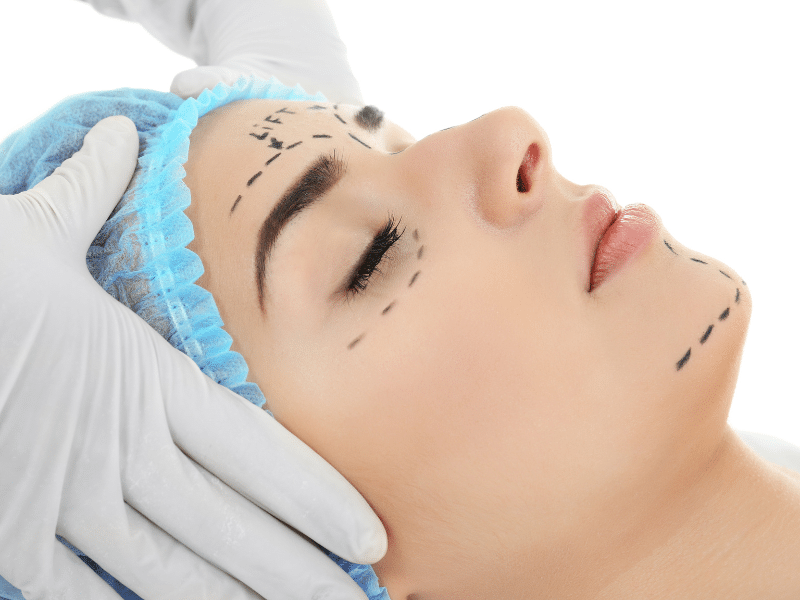
This section explores the different types of facelifts.
So this is a very commonly asked question that patients ask me, what are the different types of facelifts?
What is the best facelift for me, while this video is really going to go through that in some detail. And so first of all, well, how many different types of is that are? Well, many different types have been described. But we can really categorise these into approximately seven different types.
And so I’m going to talk you through each of the seven different types of aids that what are the benefits of each one of the downsides of each one? And, and I’ll go through this step by step.
So first of all, well, why does this matter? Why is it important? Well, in terms of the concept of the word facelift, well, if you have facial ageing, which might involve loose skin, sagging along the jaw line changes in your neck volume loss, well, sometimes this is best corrected with a facelift.
But what are the different types? what and why does it matter? What is the such thing as a non-surgical facelift? Is there such thing as a quick fix? Are there procedures that are associated with less recovery and faster healing? What are the potential downsides of the different facelift techniques? Are some more natural looking to some hide scars better than others? And what about these other kind of catchy names like threads and stem cell face the radio frequency? What are the contexts that these advancements can be used for?
So, a little bit about myself, my name is Dr. Julian De Silva and I practice in Harley Street, where my experience really is from working in London, Los Angeles and New York. And I specialise only in the face, remember ocular facial, cosmetic and plastic surgeon. And most of my practice is around eyelid surgery, blepharoplasty based elective surgery, and nose reshaping, and associated techniques that help those procedures.
A good proportion of my patients, our vision patients from patients had surgery elsewhere. And I’ve completed 1000s of procedures in in this era of medicine. So a little disclaimer, well this information is to help provide information to you, but it does not constitute a doctor patient relationship. So first of all, what’s the first type a non surgical facelift.
Well, what does this actually mean? Non in essence, it means avoiding surgery. So, non surgical techniques could be things such as Botox and fillers. net, there are also more sophisticated devices that use ultrasound, radio frequency, and these essentially a tightening the skin. Well. What are the advantages of these techniques?
Well, the advantages are they avoid surgery, so generally they have a much faster recovery. And patients can look good even after a few days after having like a non surgical treatment. And really, they’re suitable for patients who have really quite early changes. And they may be a bit more focused around losing volume and volume loss. But they’re not going to address gravity and they’re not really going to address the new skin. And so they’re quite limited in what they can achieve. But the main advantage is that they have a fast recovery and the avoid the need for surgery. And so usually they can be completed on the local anaesthetic. Sometimes with topical anaesthetic. They don’t need sedation or general anaesthetic, but then their effect is a little limited.
Now we’ve all seen celebrities and people who’ve had a little too much non surgical treatments. And usually this is in the form of fillers adding too much volume to the face. And we’re here with this photograph of Nicole Kidman we can see you know attractive youthful appearance with a very kind of V shaped jaw line which is one of the characteristics of a natural neutral jaw line.
And then this photograph just shows more volume in the lower half lower third of her face, which if anything reduces that slim v line and makes her face just fuller, and if anything was square. And so like many things life, a little bit of volume, a little bit of filler can be a good thing, but a little bit too much and then it doesn’t look as natural.
The other limitation with non surgical treatments will they don’t tend to last that long. And many treatments don’t last more than six to 12 months and then they require repeating and they require a degree of artistic talent in order to ensure that they look natural. So the second type of facelift is a skin only facelift and this really means what it says and it has other nomenklatura, sometimes it’s called a ponytail lift, and other kind of catchy names, but essentially means that it’s suitable for patients who just have a very small amount of loose skin.
And those patients can benefit from a smaller surgical procedure, that essentially just takes away a little bit of that new skin. And so it’s not lifting the structures of the face beneath the skin. And in a way, it’s important that it’s not used in patients who have more facial ageing, as it’s only going to benefit patients with loose skin.
So the advantages, well, this kind of face that is going to benefit patients who have a little bit of loose skin and mild skin, a mild facial ageing, the disadvantages and the advantages that come alongside that it requires minimal anaesthetic may be done under local anaesthetic, and patients are going to have fast recovery with maybe only a few days or a week of recovery or downtime.
The disadvantages are well, it is dependent on the fact that there’s no further facial ageing, because if there’s any effects of gravity, or there’s effect of more loose skin in the neck, well, it’s not going to give good results because it’s not going to lift those underlying anatomical features, which means that it can give them more stretch appearance.
And that was the the downside of the very early techniques of facelift surgery tend to get very kind of stretched lines in the skin because it focused on lifting the skin and not the net layers beneath. So in some ways, it’s it’s a technique that does have an advantage for small number of patients with early facial ageing and a little bit of loose skin. But for many patients, it’s not going to be adequate.
So the third type of facelift is a max facelift. And this is a rather fancy name for minimal access cranial suspension. And this technique really focuses on using three stitches to lift the face where has descended and remove the skin. So in surgical practice two relatively straightforward technique. And the advantage of that is it’s does produce good results, it does make an improvement, but it is really dependent on patients having relatively mild facial ageing, and relatively little changes in their neck area.
And, and so the advantages are fast recovery, it can be done in the relatively light, anaesthesia, localised, progressive with sedation. The disadvantages of a max case that well, it tends to be less effective in the neck area doesn’t control the neck in the same way. And it doesn’t tend to effectively remove loose skin. And the fourth type of facelift is a mini facelift. And really, this is half a face and neck it means what it says.
And so the scars are really limited to an area in front of the air. So there’s no scars going behind the air. And because of that the main advantages are for patients who have facial ageing in the lower third of their face, you might have some effects of gravity with jowls, soft tissues from the cheek just descending down and creating more fullness along the lower jaw line and so many faces, which is lift that era back up and smoothing out the jaw line and the scars are concealed around the front of the ear and within the hat. And this technique means that there’s no surgery behind there, and there’s minimal surgery in the neck area. And so because it’s a mini facelift, well it takes half the amount of time does a full face and neck lift. And so the recovery and the healing is also much faster than the swelling will be less and the recovery may be in the order of one to two weeks in terms of the majority of the swelling majority healing occurring.
The downsides of a mini facelift is that well, if there are changes in the neck such as bands in the neck, or if there’s more loose skin. All patients need additional techniques to get the best result, but we won’t get the very best natural results.
There are also variations in terms of descriptions of the mini facelift techniques such as described like an S lift, but they’re all variations on the same concept. So many festive absolutely has an advantage for some patients but there have to be relatively mild to moderate changes with less changes in the neck area. And then the fifth type of facelift is a smart facelift and this is the commonest type of facelift completed by plastic surgeons.
And this technique absolutely improves the lower third of the face lifts the area of the face, it improves the neck area. Now most of the direction of ball tends to be in a lateral direction. So in this in this picture is illustrated with this blue arrow. So most of the lift is working in this direction, which improves the jaw line our neck. It does require anaesthetic, either sedation anaesthesia, or Twyla anaesthesia, whichever anaesthetic, it will be associated with some recovery, including swelling, sometimes bruising, numbness, a feeling of tightness.
And you really need a good two to three weeks, if not a little bit longer for most of the swelling and recovery to occur. The main disadvantage of this technique well, because of the procedure that does involve surgery, there will be a recovery time associated with it. And so you need time dedicated for that. It does, it does result in a lateral lift. And so that lift is not necessarily a natural lift, because most of what changes with gravity tends to be in a downward direction. And so the lift is not so natural because it’s pulling more lateral direction. And sometimes additional procedures are needed like in the cheek area in order to restore volume.
So that the sixth type of face there is a deep plane facelift. And then this facelift, well, it really says what it is it lifts the deep layers of the face, and then lifts in a vertical upward direction. Now a lot of the changes that happen with facial ageing are associated with gravity intend to be in a downward direction. So this type of research really restores the natural volume in the cheek area by lifting this air out and restores a more youthful V shaped the joy. So it’s a more natural kind of face. The challenges were busy to more sophisticated, sophisticated type of technique. And so less than 5% of plastic surgeons repeat this technique.
And it is a technique that definitely offers a more natural appearance because it restores more of a V shaped jaw line to a face. It can be used in conjunction with other techniques and the use of the golden ratio to give more of a natural result. I personally prefer this for patients who have further facial ageing in the face from the neck because I believe it gives faster recovery and less swelling associated with the healing process. So the seventh type of face that was in a way this is a more sophisticated technique in terms of patients who have additional need in association with their patient characteristics.
So for example, this lady has a very full neck and shows her neck standing almost where chin is and this lady even in her 20s had a full neck and so part of the reason for this fullness is there’s like deeply soft tissues. Often the saliva glands rather than being tight underneath the jaw line, or the saliva glands have just descended in the neck. And often there’s deep fat is within this now. So in order to create this really sharp angle between the jaw and the neck, well it requires deep Neck Surgery shaping of the underlying saliva glands and Deepak and that will give him very good neck contour. The downside is it’s associated with more swelling and more recovery.
And so patients need to be made aware that they absolutely all swelling will disappear, but this kind of surgery will have a bit more recovery associated with it. Then there are patients who might have like smaller chin will benefit from the chin implant or other complimentary techniques. Patients who have a lot of ageing of the saggy skin or some damage are going to benefit from either research fussing with lasers or or radio frequency like a Morpheus.
And there are techniques that can also enhance the recovery such as use of Regenerative Medicine. So, in summary, what we’ve talked about really the seven core types of facelift surgery. And just to recap is, well, we’ve got a non surgical facelift, which is not a true facelift and use different kinds of tools and equipment in order to non surgically lift the face. And the limitation is it’s really like in early facial ageing that these techniques are going to be used. And it requires artistry to avoid overtraining and overfitting.
He talked about the second type of skin only type of face that really benefits patients who only have very mild skin laxity, and it just requires just tweaking that little bit of excess skin. The third type the max facelift, which is a technique that is relatively straightforward, it uses three stitches to lift the face, and its limitation is really in the neck area and patients who have more loose skin.
The fourth type of mini facelift while this really is a technique that benefits patients with early to moderate facial ageing, and it won’t really enhance or improve changes in the neck and bands in the neck. The smash facelift, which is the core facelift, that most plastic surgeons utilisable. This absolutely makes a difference it’s back to tends to be more in a lateral direction. But it is associated with a degree of recovery from swelling and bruising. And so patients need time to recover from this procedure.
Then the sixth type sit my signature deep plane facelift. Well, the deep play face that definitely lifts in a more vertical direction. And so it tends to produce a more natural result in a more V shaped youthful jaw line. And there’s some evidence that it results in less recovery time, less swelling, less bruising. And then the seventh is other techniques, patients who might have forged neck which is just a result of genetics inherited from their parents. While these, this requires a bit more surgery in this area to give the best possible.
So in summary, these are the seven different types of blackface and procedures. How do you choose what is the best technique for you? Well, it can be a challenge because even with this information, each person’s face is very much unique. And so the technique for that, for face of surgery very much has to be customised to your individual needs.
And so you do need to do some research and have some knowledge and I hope this video has helped you in that regard. You do need to see a specialist who’s doing a lot of facelift surgery is going to be able to guide you on what’s going to be the best for you in terms of give you the best result and give you the fastest recovery. There’s a degree of experience and artistry with facelift surgery and there’s no technique that is going to suit every single patient. And rarely, there is no quick fix. And you would be great if there was just one simple technique that would help every patient but really there’s no such thing.
So good luck in your search. And if there are any other questions or thoughts that would be helpful, please, please make a note on this video. If you’d like to sign up for my newsletter, please do that or if you’d like to attend in a consultation. I’d be very grateful to help you either virtually or in person. I hope this video has been useful for you. Thank you for watching.
Knowing what are the different types of facelifts helps you understand the benefits.
Please take note that your face is unique. The best type of facelift requires a thorough assessment. You can contact us for an extensive consultation. Also, make sure that you don’t make the biggest mistakes when choosing a surgeon.
What Is a Lower Facelift?
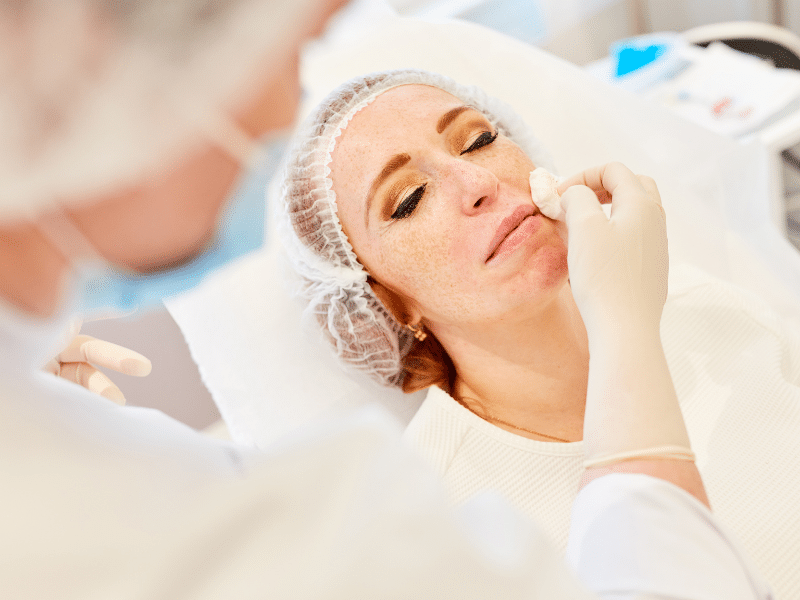
A lower facelift UK is less invasive than traditional, full facelifts.
So what is a facelift on the lower side of your face?
Compared to a full facelift, a lower facelift is less invasive. This helps minimise pain, side effects, and scarring.
Only board-certified surgeons can perform lower facelifts. Surgeons work on lower facelifts by creating a small easily-concealable incision. It’s done under anaesthesia.
Your mouth’s corners can also be raised during the procedure. This gives you a more natural well-rested and happier appearance.
Most of the patients prefer to go back to work at least a week or two after their lower facelift procedure. However, complete recovery from the procedure could take several weeks.
Advantages of a Lower Facelift
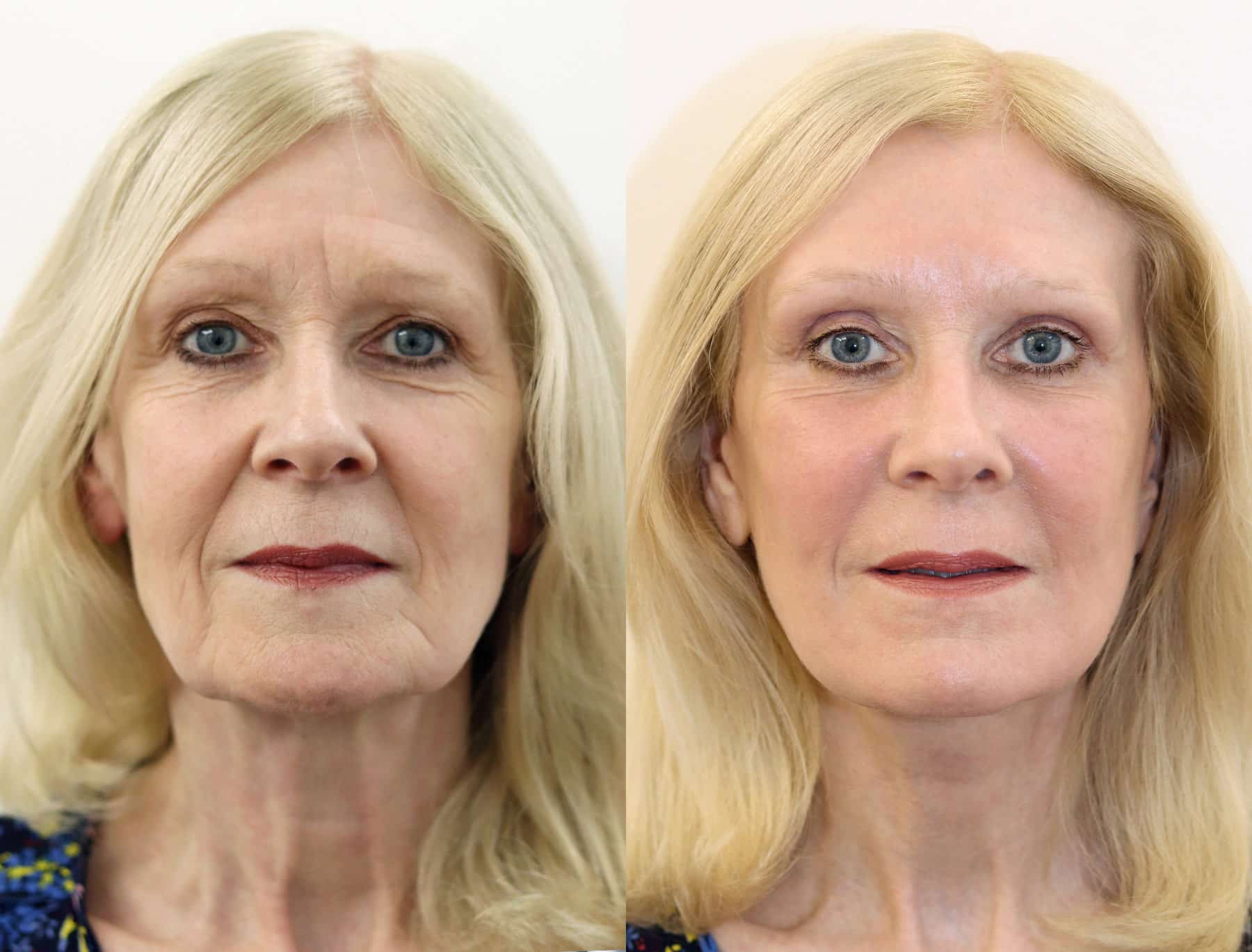
A lower facelift before and after changes how you perceive yourself and increases your confidence.
Here are the pros of getting a lower facelift:
1. A lower facelift tightens your facial muscles.
With time, muscles from the underlying structure of your face become weak. They also sag over the course of time.
These muscles can be tightened with a lower facelift. Other than the muscles, a lower facelift can also fix loose skin.
2. A lower facelift improves facial contours.
The procedure helps create a more attractive jawline contour. This can be achieved by eliminating jowls.
Smoothing the area of the neck also helps. Additionally, a liposuction procedure can be carried out around the neck or jowls.
3. A lower facelift produces permanent results.
Unlike non-surgical facelifts, a surgical lower facelift produces permanent results. This means that you can enjoy the results of the procedure for decades or up to a lifetime.
My patients often enjoy the results for several years. Some of them enjoy the results for a lifetime.
4. A lower facelift boosts your confidence.
Undergoing a lower facelift can increase your confidence. Receiving the procedure also gives you a more positive outlook on life.
When you have a more youthful appearance, people may start to look at you differently. Thus, you become more confident in yourself and your capabilities.
5. A lower facelift works well with other procedures.
A lot of patients choose to have other procedures done at the time of their facelifts. Doing this can improve the overall results of the combined procedures.
Other procedures that can be done with a lower facelift include blepharoplasty or eye lift, cheek implants, and neck lift.
Lower Facelift Expectations
The results for the lower facelift will almost immediately be noticeable. You can expect a firmer, smoother, and more contoured appearance. In addition, you can expect swelling and bruising after the operation.
On the other hand, your best results will start to show up. A lower facelift procedure can take as much as ten years off your present facial appearance.
Other procedures can also be paired with a lower facelift procedure for further enhancement. These enhancing procedures may include a mid-facelift or a neck lift. Plus, you can make the most out of your lower facelift cost by combining treatments. It also gives you total rejuvenation in a single recovery period.
Find out more in our detailed blog post on what is a lower facelift?
What Is a Ponytail Facelift?
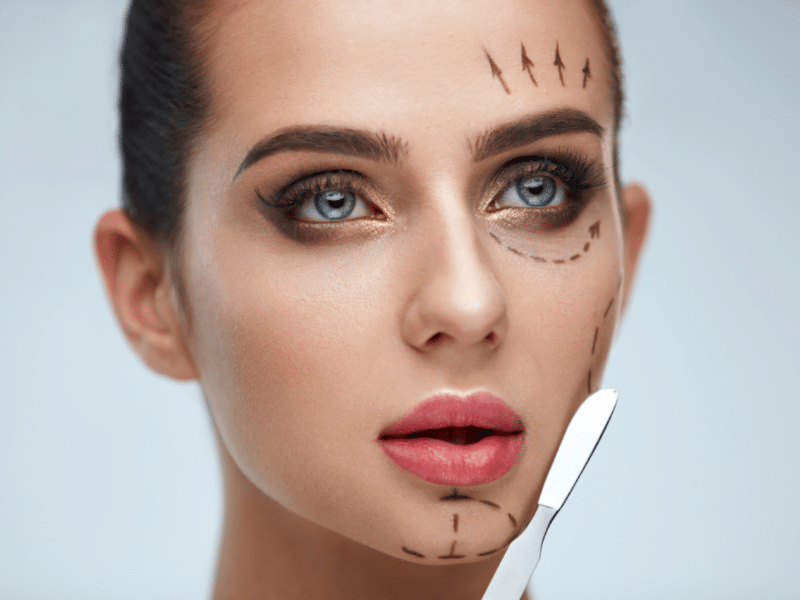
This facelift mimics that of fastening one’s hair into a tight, high ponytail.
There are many types of facelifts: deep plane, SMAS, mini facelift, full facelift, lower facelift, and more.
The meaning behind its breezy ponytail facelift name is apparently two-fold.
First, the lift’s effects are meant to be like fastening a person’s hair into a tight, high ponytail. This has the effect of pulling the skin of the scalp and, subsequently, the forehead, cheeks, and brows upward. Doing so creates a more elevated and youthful appearance.
Second, the procedure gives the effect of a facelift without the traditional scars of a facelift. Since scarring (which would traditionally be in front of the ears) is minimal, the patient is theoretically able to wear their hair in a high ponytail without fear of exposing obvious scars.
Ponytail Facelift: What the Endoscopic Facelift Involves

A ponytail facelift is technically a type of endoscopic facelift.
In particular, the qualified facelift surgeon performs the endoscopic surgery using small instruments, a tiny camera, and small incisions that are made far away from the area trying to be lifted (usually along the temporal hairline).
These small incisions allow the surgeon to lift the underlying connective tissues (technically called the SMAS). However, it does not lift any skin—this would have to be cut out via another larger incision.
On the positive side, it is less invasive, so scarring is minimal. In addition, the downtime and recovery time are less than that of a traditional facelift. Also, as with any type of facelift, the results are long-lasting.
When you do an endoscopic procedure, it’s great that you can have an incision that’s far away from the area that you want to lift. By doing this, the surgeon can hide the incision within the hair on the scalp.
However, the downside is twofold. For one, you can’t remove any excess skin. Secondarily, you run the risk of losing hair since the incision is usually near or on the scalp. If it heals improperly, it could damage the surrounding hair follicles.
Best Facelift Surgery
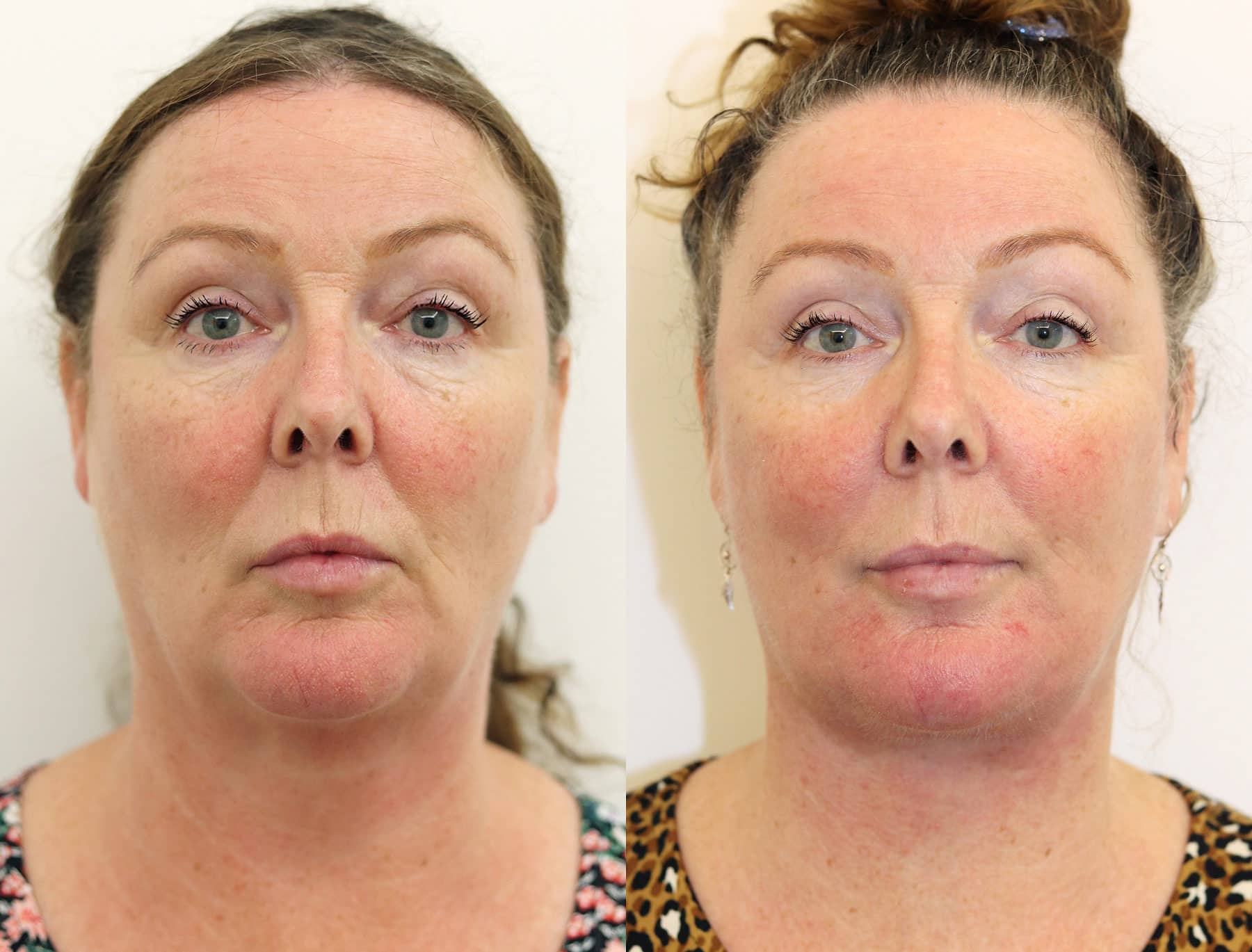
The signature deep plane facelift is the best facelift surgery. Less than 5% of surgeons can do this advanced procedure.
The signature deep plane facelift is the best facelift surgery offered in my clinic.
For starters, it is the most advanced surgical facelift type― performed by less than 5% of plastic surgeons.
The deep plane facelift leaves the skin attached to muscle layers, and lifting only under these muscle layers. This procedure also lifts the cheeks by releasing the tied points of the face, eliminating the addition of filler or fat.
By doing these, the signature deep plane facelift produces more natural results compared to other surgical facelift types.
I personally developed a signature deep plane facelift. It is based on my extensive research and many years of experience in cosmetic surgery. Just like my signature phi lift procedure, my signature deep plane procedure is also based on the golden ratio.
|
Best Age |
Early 40’s to 60’s |
|
Best Candidates |
People with significant fine lines and wrinkles People with significant facial volume loss People with extremely sagging skin People with noticeable jowls |
|
Risks |
Bruising, swelling, and bleeding |
|
Recovery Time |
2 weeks |
| Results |
Natural look Younger look Subtle changes Reduced fine lines and wrinkles Improved facial volume Lifted skin Less noticeable jowls |
Other Surgical Facelift Types
There are times when a deep plane facelift is not suitable for you. Here are other best facelift procedures you can have.
Skin-Only Facelift

Many patients choose the skin-only facelift procedure because it doesn’t disturb their muscles and only lifts the skin.
As its name suggests, the skin-only facelift procedure only lifts your skin. It does not lift the tissue under it.
From my experience, many patients choose the skin-only facelift procedure because it doesn’t disturb their muscles.
In addition, this type of facelift produces fast results, making it ideal for those who want to see immediate results. It also causes less pain compared to other traditional types of facelift.
|
Best Age |
30 to 40 |
| Best Candidates |
People with few to moderate signs of ageing People who want to slow down the signs of ageing early |
|
Risks |
Bruising, swelling, and bleeding |
| Recovery Time |
1 to 2 weeks |
| Results |
Natural look Subtle changes Immediate results |
SMAS Facelift

An SMAS facelift tightens your muscles and skin. It is the solution to your sagging cheeks, fleshy jowls, and double chin.
SMAS stands for superficial muscular aponeurotic system. Hence, the SMAS facelift is a procedure that targets the said area.
As you become older, your SMAS becomes less elastic. This results in sagging cheeks, fleshy jowls, and a double chin. The SMAS facelift can reverse these effects.
Specifically, the SMAS facelift involves tightening your muscles, trimming excess skin, and removing fat.
|
Best Age |
40’s to 60’s |
| Best Candidates |
People with moderate to extreme signs of ageing People with sagging cheeks, fleshy jowls, and double chin |
|
Risks |
Bruising, swelling, bleeding, delayed wound healing |
| Recovery Time |
3 to 8 weeks |
| Results |
Natural look Lifted cheeks Reduced jowls Less noticeable double chin |
Mini Facelift
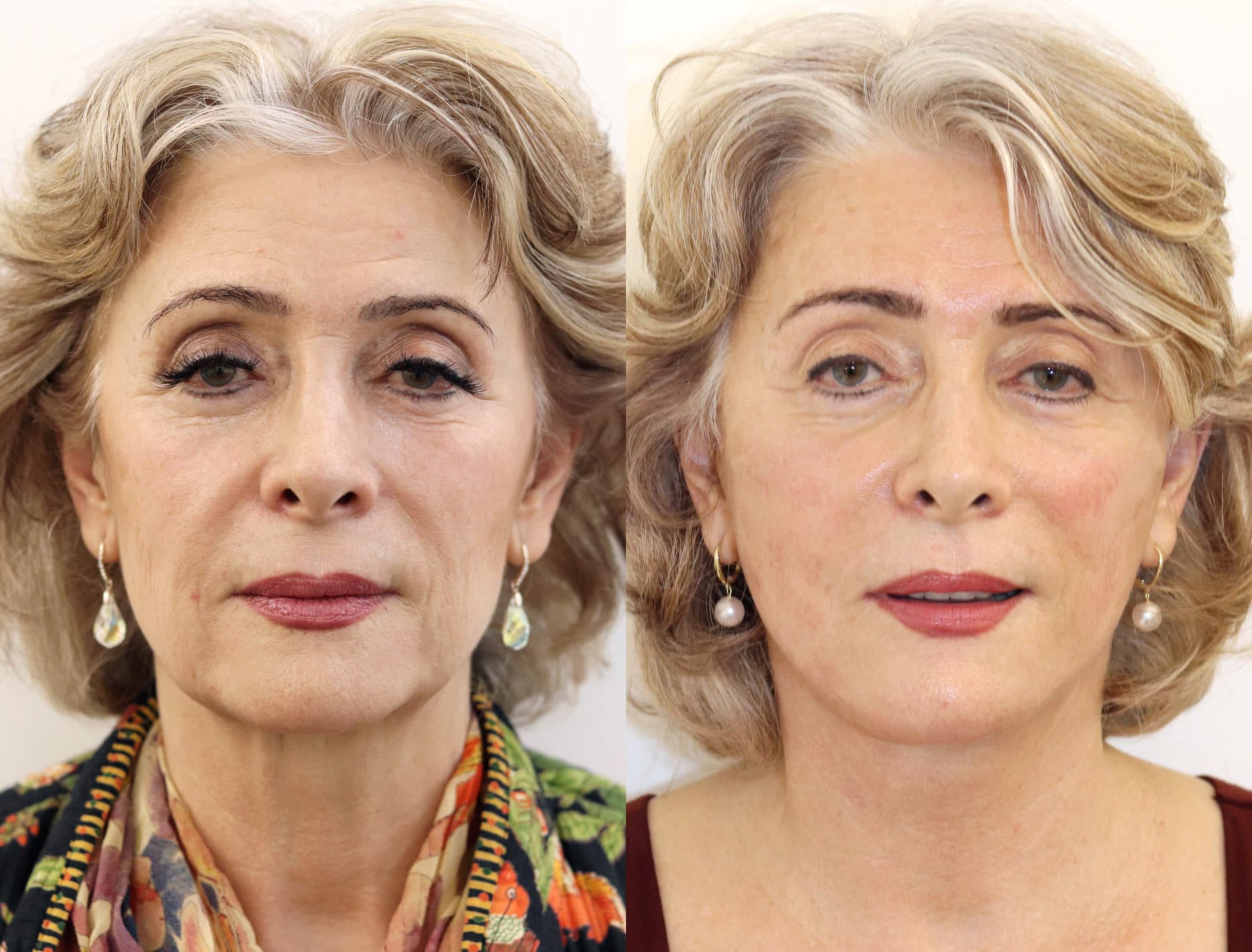
A mini facelift targets the lower half of your face. This surgical facelift procedure is done by making small incisions.
A mini facelift is done by making small incisions. Since the incisions are small, it produces less dramatic results than a traditional facelift.
In particular, I use small incisions around your hairline to solve your issues. I then remove excess skin to tighten your face and reduce your wrinkles.
Sometimes, other procedures must be done with a mini facelift to maximise the results. It’s because a mini facelift procedure only involves the lower half of your face.
|
Best Age |
Late 30’s to 40’s |
|
Best Candidates |
People with significant problems with the lower half of the face People with loose skin and wrinkles |
| Risks |
Bruising, swelling, bleeding, scarring |
|
Recovery Time |
1 to 3 weeks |
| Results |
Natural look Subtle changes Improved lower half of the face Tightened skin Reduced wrinkles |
S-Lift

The S-lift is a conservative surgical procedure that is mainly chosen by patients because of its short recovery time.
The S-lift is named after the S-shaped incisions made during the procedure. This procedure involves removing skin from your midface.
Specifically, I begin the S-shaped incision at the hairline. I then continue the incision on the front and back of the ear. After creating the incision, I reposition the tissues. Lastly, I remove the excess skin and fat.
The S-lift is mainly chosen by patients because of its short recovery time. It is also more conservative compared to other procedures in this list.
|
Best Age |
Late 30’s to 60’s |
| Best Candidates |
People who want to recover fast People with loose skin and jowls |
| Risks |
Bruising, swelling, bleeding |
|
Recovery Time |
3 to 5 days |
| Results |
Natural look Subtle changes Tightened skin Less jowls |
MACS Facelift
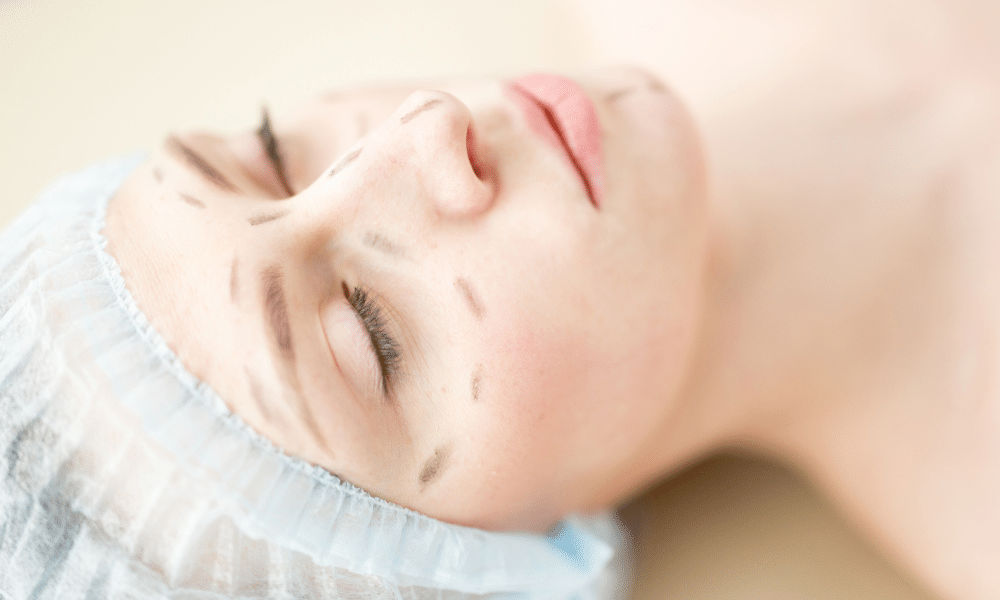
The MACS facelift procedure targets the face’s underlying muscles. It tightens your muscles and removes some skin.
MACS stands for minimal access cranial suspension. The MACS facelift procedure targets the underlying muscular structures of the face.
I start doing an MACS facelift by making an incision at the hairline. I then continue to the front of the ears.
After that, I tighten the facial muscles. In some cases, I have to separate the skin from the soft tissue and remove some of that skin.
|
Best Age |
Late 30’s to 60’s |
| Best Candidates |
People with wrinkles under their eyes People with noticeable jowls People with deep lines on the corner of the nose and mouth |
|
Risks |
Bruising, swelling, scarring, bleeding |
|
Recovery Time |
3 to 4 weeks |
|
Results |
Natural look Mildy subtle changes Reduced wrinkles, jowls, and deep lines |
What Maintenance Do I Need After a Facelift?
A facelift may be a miracle worker for you, but you need to maintain its results. Hence, doing much-needed maintenance is crucial if you want to enjoy your facelift results for a long period of time.
But how exactly do you do that? Are there guidelines you can follow for maintenance after a facelift?
In this article, I will talk about how long a facelift usually lasts and the things you can do to maintain its results as long as possible. I will also discuss non-surgical treatments for maintenance after a facelift.
How Long Does a Facelift Last?
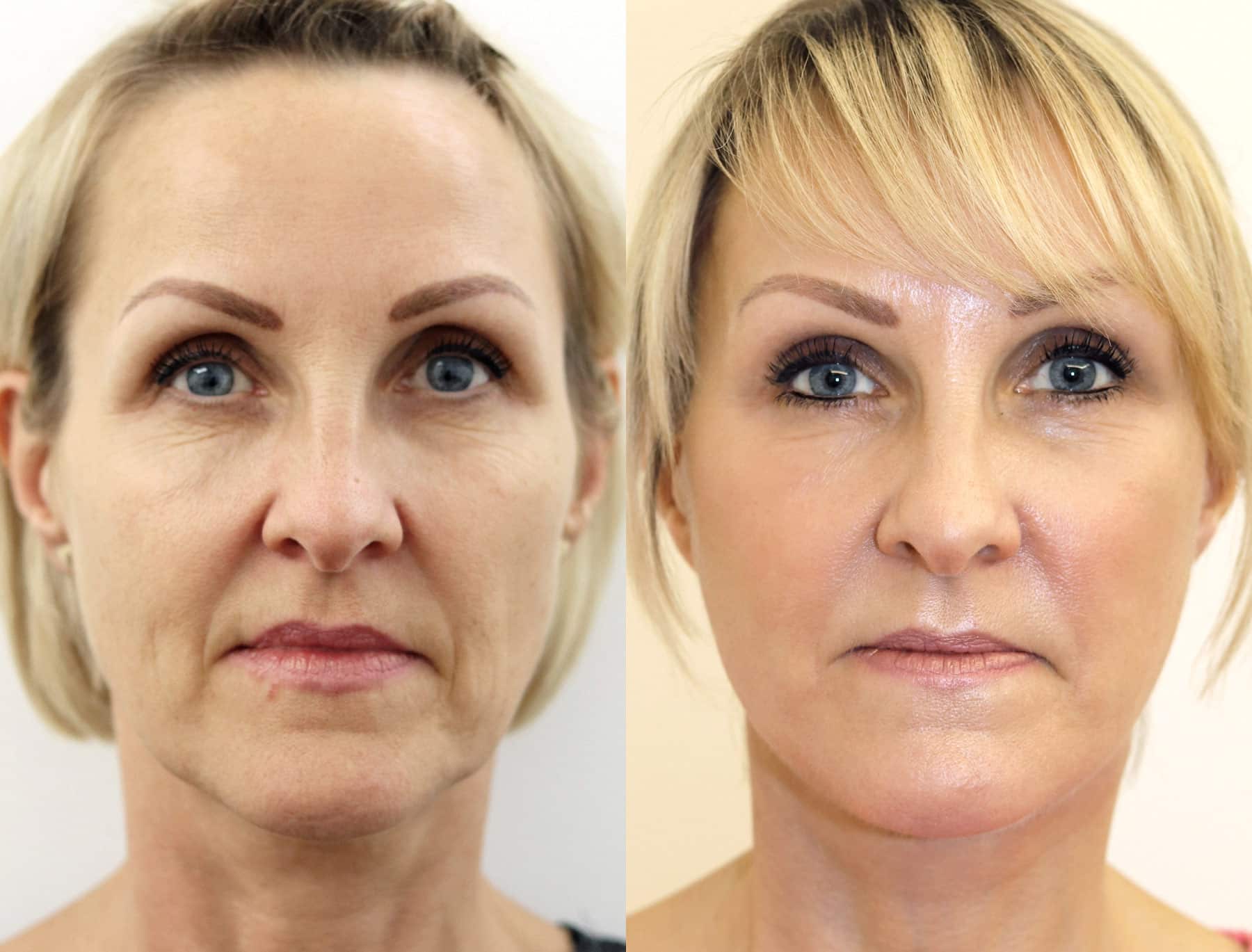
You can make a facelift’s results last longer with maintenance after a facelift.
Facelift surgery usually lasts for up to one decade. However, a facelift might last longer if you invest in yourself and maintain your appearance year after year.
I, Dr. Julian De Silva l, hope to continue to care for you after your facelift surgery. I will see you annually and give you continuous care by forming long-term connections with you, should you choose to be my patient.
The patient’s skin quality, the specific technique used by their plastic surgeon and the lifestyle they lead in the years after their procedure are all factors that can influence the lifetime of facelift surgery outcomes.
In general, healthier, younger skin that has retained some suppleness is more resilient after surgery. The quality of one’s skin is frequently a good indicator of whether or not a facial rejuvenation procedure will be successful.
Facelift procedures that just tighten loose skin don’t usually provide benefits that endure as long as those that elevate and tighten both the skin and the underlying muscles of the face.
Patient Measures for Maintenance After Facelift

Maintenance after facelift includes playing your part in it.
Here are the things you can do for maintenance after a facelift:
Wear sunscreen.
The sun’s UV radiation can hasten facial ageing and cause more wrinkles and sun damage, including hyperpigmentation. Apply sunscreen every day to protect your skin from UV damage (SPF 30 or above).
Maintain a healthy lifestyle.
Avoid smoking, which causes skin ageing, extra facial wrinkles, and a loss of natural facial fat and elasticity. Healthy living entails moderate alcohol use, as well as avoiding weight fluctuations, which can wreak havoc on your facelift outcomes. Eating healthily, drinking enough water to stay hydrated throughout the day, and exercising can all help you achieve your goals.
Use high-quality skincare products.
A consistent skincare routine, which includes sun protection and, in certain cases, retinol, can be beneficial.
Manage your stress levels.
Chronic stress is bad for the entire body, so it’s important to control it. Stress has been demonstrated in studies to hasten cellular ageing, which has health concerns. Working on anxiety management, positive energy, and overall well-being goes a long way toward enhancing health and well-being.
Drink plenty of water every day.
Hyaluronic acid is one of the key components in many dermal fillers. The extraordinary ability of hyaluronic acid to capture and retain water is one of the reasons it is utilised to restore volume at injection sites.
Thus, you must maintain hydrated if you want your skin to seem as tight and smooth as possible, whether or not you use hyaluronic acid injectable treatments. Make it a habit to drink at least two liters of water (eight glasses) every day after you’ve had a facelift.
Get your rest.
Another severely underappreciated skin care tip is to make sure you’re getting enough sleep. This is particularly important during and after your facelift recuperation.
When you don’t get enough sleep, your body creates more cortisol, the stress hormone. It not only aids weight gain as your body prepares to deal with increasing stress levels, but it also causes significant inflammation and increases oedema. Make sleeping well a priority if you want healthy, smooth skin.
Non-Surgical Treatments
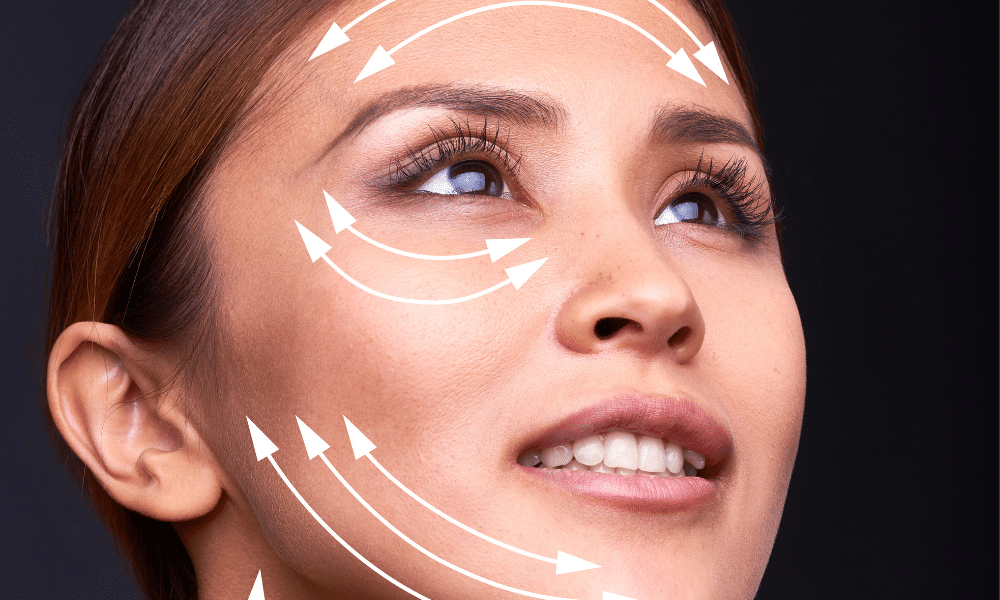
Non-surgical treatments help with maintenance after a facelift.
My aim is to provide lifelong support to our patients. Here are non-surgical treatments for maintenance after a facelift:
Botox
Despite the fact that Botox is a highly effective non-surgical treatment option, it’s crucial to know what it can and can’t achieve.
For one, Botox is an injectable neurotoxin that works to relax the muscles that cause wrinkles on the face. It is commonly used to reduce wrinkles on the forehead, around the eyes (crow’s feet), and between the brows. The effects of Botox usually last three to four months before requiring a follow-up treatment.
Patients frequently inquire about whether or not they will require Botox after undergoing a surgical facelift. While a facelift will undoubtedly result in a dramatic and striking new appearance, patients should be aware that a standard facelift focuses on the mid and lower face.
Hence, patients who use Botox to smooth out action lines on the forehead and around the eyes on a regular basis can benefit from ongoing injections, even if they may be able to get treated less frequently than before their facelift.
Laser Resurfacing
Laser skin resurfacing is a procedure that reduces facial wrinkles as well as skin imperfections including blemishes and acne scars.
In short, concentrated pulsing laser beams are directed towards uneven skin, carefully eliminating skin layer by layer.
If you have fine lines or wrinkles around your eyes, lips, or forehead, superficial acne scars, or non-responsive skin after a facelift, laser skin resurfacing may be right for you.
However, you may not be a candidate if you have acne or very dark skin. Stretch marks should not be treated with this method. Before undergoing laser resurfacing, you should consult with your doctor to see if it is the best operation for you.
I, Dr. De Silva, have invested in the latest state of art laser that tightens deeper and superficial skin. I use this in combination with PRP (platelet-rich plasma) to heal your skin faster.
Radiofrequency
Radiofrequency (RF) tightens the skin millimetres at a time.
Tighter skin and a smoother surface – meaning fewer wrinkles – are the two most evident effects of this procedure. However, because RF therapy is so adaptable, you can also anticipate seeing a reduction in solar damage. Patients reported clinically significant improvements in mild to moderate indications of sun damage after three months of RF treatment, according to studies.
RF treatments stimulate the body to manufacture new collagen and elastin. Old, damaged skin is replaced by new, healthy skin as a result of these impacts. These cells are inherently firmer and tighter, but it takes time for them to mature. You will not appear one way on Thursday and another on Friday or Saturday.
The majority of patients seek gradual changes because they want to appear like themselves, but better. They’re searching for modest changes rather than drastic ones, and RF gives exactly that.
Fillers

Dermal fillers help with maintenance after a facelift.
Occasional fillers made of hyaluronic acid will replenish lost volume in moderation, as too much filler looks fake.
Larger portions of your face lose volume and shape as a result of ageing changes beneath the surface of the skin, where the gradual loss of supportive tissue structures and the long-term effects of gravity cause larger areas of your face to lose volume and shape. The cheekbones and chin are particularly affected by these changes.
Dermal filler treatments are used to increase volume to beauty spots or to replenish the volume that has been lost. We employ dermal fillers to lift and sculpt the face for immediate effects that last 6 to 24 months.
Advanced dermal fillers also help to replace hollows and build up cheekbones, restoring ageing volume loss in our cheeks. Although numerous hyaluronic acid filler products can be used, some offer qualities that benefit the cheeks and function well in places where there is more volume loss.
With our filler treatments, you may expect to see immediate results. After treatment, there will be some little swelling that will go away overnight for the majority of individuals. Mild swelling can last up to five days in rare cases. There’s also a chance that you’ll get a slight bruise, but it’ll go away in a few days.
The complete results of fillers will be seen roughly five days after the swelling has subsided for most individuals. The benefits of our cannula-based approach, deeper filler application, and filler selection may last 18–24 months, though results vary from patient to patient
Platelet-Rich Plasma (PRP)
PRP injections or regenerative medicine are characterised as a vampire facelift because it improves skin quality.
A vampire facial, also known as a PRP facial rejuvenation, is an innovative skincare procedure that uses your body’s own inherent healing capacity.
Magic happens when platelets in plasma are concentrated. All four components of your blood are segregated by density to achieve concentrated quantities of platelets in plasma.
Oxygen Therapy
An oxygen facial is a procedure that involves using a machine to enhance collagen formation while also nourishing your skin.
The epidermis, or the outer layer of your skin, is sprayed with extremely concentrated oxygen molecules by the oxygen facial machine. This concentrated oxygen is given to your face and neck using the equipment.
An oxygen facial works by infusing your skin’s outer layer with all of the important vitamins and minerals, as well as botanical extracts, using a machine. In fact, many famous celebrities, including Madonna, favor this option.
This is your path to smoother, healthier, and plumper skin, and we’ll show you how it’s done.
Furthermore, skin cells are constantly dying and regenerating, and an oxygen infusion can speed up the process. This helps the skin repair more quickly, which aids in the healing of acne and accompanying scars.
An oxygen facial is a popular anti-ageing therapy. This is because it increases the creation of collagen, a protein that helps hold skin cells together. Collagen deteriorates with age, as does the link between skin cells, resulting in wrinkles. With its collagen-boosting characteristics, an oxygen facial can help counteract this effect.
LED Therapy
LED therapy (Light Emitting Diode) is a non-invasive treatment that uses light-emitting diodes for a number of aesthetic and medical goals. This sort of light treatment has been around for a while and can be used by people of various ages and skin tones. It can also be used in conjunction with other procedures, such as facials and radiofrequency treatment, with no harmful side effects
Some of the benefits of choosing this type of light therapy include increasing the production of elastin and collagen and supporting the detoxification of cells.
If you want effective LED therapy in London, you should work with a board-certified specialist like me, Dr. De Silva, who has a track record of producing amazing, natural-looking results using non-invasive methods.
Any region of the body might be affected by skin problems. Fortunately, at Harley Street Face Clinic, LED therapy can be utilised to effectively treat a range of issues without the use of intrusive procedures.
LED therapy with me on Harley Street in London can help speed wound healing, renew the skin, and decrease visible scars, in addition to the list above. This is dependent on the wavelength of the light being used, therefore selecting a reputable skincare specialist will increase your chances of achieving excellent results.
Tanning After Facial Plastic Surgery
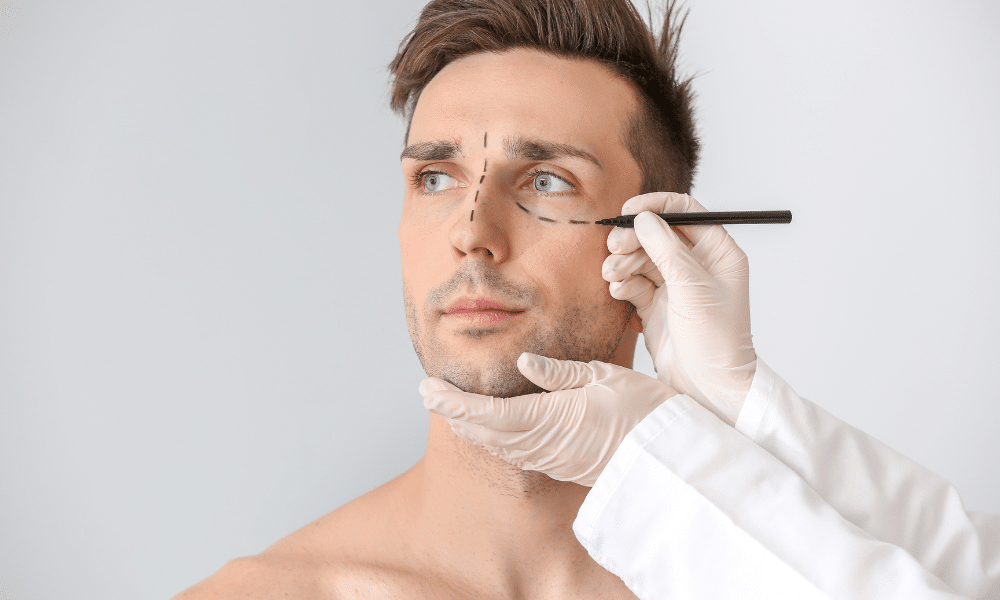
One of the most common questions patients have after plastic surgery is whether they can get tanned or not.
Are you wondering if you can get tanned after facial plastic surgery? In this section, I’ll talk about tanning after facial plastic surgery.
Perfect Season for Facial Plastic Surgery
If you have decided to undergo plastic surgery and are ready to line up your appointment, you may want to consider scheduling the procedure for the fall or winter months. There are several compelling reasons to book a fall or winter visit to the cosmetic surgeon: cold weather can be an excellent excuse to nest and take the time needed to recuperate; the holidays can be a convenient opportunity to score an extra day or two off work; and, perhaps most importantly, autumn and winter skies can offer some buffer to excessive sun exposure.
After a facial plastic surgery procedure, you can help your body heal by moderating activity, following a healthy lifestyle, and minimising UV exposure. It is best to slow down, drink plenty of water, and treat yourself to some rest and relaxation. Tanning–best eschewed under normal circumstances–should absolutely be avoided for up to six weeks following any facial plastic surgery such as a blepharoplasty, a rhinoplasty, or a rhytidectomy.
As most of us already know, UV light damages the skin and accelerates ageing. Post-surgical skin is particularly sensitive to UV exposure because its natural defenses are down. Not only is tanning an impediment to the healing process, but it also increases the risk of undesired side effects, including permanent skin discoloration. If you tan or burn, you definitely up the chances of creating visible scars.
Unfortunately, once a healing scar has been burned, the damage is done. It is best to err on the side of prevention. So, be sure to carefully cover any incision sites.
Recovering from Plastic Surgery in a Sun-Drenched Place
Although the autumn and winter months may be more conducive to healing in some climates, a season-based appointment may not make a difference if you live somewhere with year-round sun. If you are accustomed to a daily dose of sunlight, you will have to be extra vigilant in protecting your skin after facial plastic surgery. Wear a hat, stay in the shade as much as possible, and always wear high-SPF sunscreen. Bypass that trip to the beach or the pool and instead enjoy a picnic in the leafy shadows of a tree.
Although it may be tempting to bask the face in sunlight once your skin has fully healed, you may want to rein in that urge. In truth, protecting the skin from UV rays should be part of everyday life. To increase the longevity of your facial plastic surgery, it is highly recommended that you make this post-procedure sun habits a part of your normal routine. Whether you undergo a blepharoplasty, rhinoplasty, or facelift, the same rule applies: always safeguard your skin.
Your Facial Plastic Surgery Consultation with Dr. De Silva, London
If you have been thinking about plastic surgery and would like to know more about preparations and precautions, contact me for a comprehensive consultation. As a facial plastic and cosmetic surgery specialist, I can provide recommendations and assistance both before and after your cosmetic surgery.
Conclusion
I hope this blog has been helpful in explaining everything you need to know before considering a facelift.
Remember, every facelift journey is unique, but this guide is designed to help you at every step. If you have more questions or are ready to take the next step, don’t hesitate to book a consultation with me. I can give you personalised advice and answer any other questions you might have.
Remember, getting a facelift is all about helping you feel more confident and happy. Contact us to book a consultation now and start your journey to a better, more confident you. All the best!

